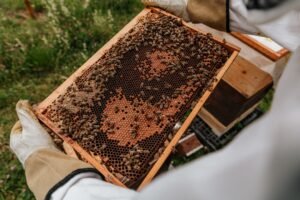Comprehensive Guide of Charcuterie
Overview
Charcuterie is the art of preparing and assembling cured meats, cheeses, and various accompaniments to create visually appealing and delicious platters. This culinary hobby allows individuals to explore their creativity while indulging in the flavors and textures of different ingredients. Charcuterie boards can include a variety of items such as salami, prosciutto, cheeses like brie and cheddar, fresh fruits, nuts, olives, and artisanal bread. The process of creating a charcuterie board is not only about the food itself but also about presentation, making it a popular choice for gatherings, parties, and special occasions. This hobby encourages experimentation with flavors and pairings, allowing enthusiasts to develop their palate and impress guests with their culinary skills.
History
The history of charcuterie dates back to ancient times when the preservation of meat was essential for survival. The term ‘charcuterie’ originates from France, where it referred to the preparation of pork products. In the 15th century, charcutiers (pork butchers) began to create a variety of cured meats, including sausages and pâtés, which became staples in French cuisine. Over the centuries, the practice of charcuterie expanded beyond France, with different cultures developing their own methods of meat preservation and preparation. Today, charcuterie has evolved into a culinary art form, with modern interpretations incorporating a wide range of ingredients and styles, reflecting global influences and contemporary tastes.
Popularity and Demographics
Charcuterie has surged in popularity in recent years, becoming a trendy hobby among food enthusiasts and home entertainers. Social media platforms, particularly Instagram and TikTok, have played a significant role in popularizing charcuterie boards, with users sharing their creative designs and unique ingredient combinations. This hobby appeals to a diverse demographic, including young adults, families, and foodies of all ages. Many people are drawn to charcuterie for its social aspect, as it encourages sharing and communal dining experiences. Additionally, the rise of gourmet food shops and online retailers has made it easier for hobbyists to access high-quality ingredients, further fueling the growth of this culinary trend. Workshops and classes focused on charcuterie are also becoming increasingly popular, allowing individuals to learn the skills needed to create stunning boards for any occasion.
Sponsored Hobbyists and Vendors
Become a Sponsor!
Affiliate Disclaimer: Throughout some sections below, Hobby Spotlight may suggest some tools, equipment or material using affiliate links. By purchasing any of those items, Hobby Spotlight may earn a small commission. This helps fund our website, content and services without directly charging our users.
Getting Started
Essential Charcuterie Tools:
Beginner
- Cheese Board: A wooden or slate board for arranging charcuterie items.
- Cheese Knife Set: A set of knives specifically designed for cutting different types of cheese.
- Serving Utensils: Basic utensils for serving meats, cheeses, and accompaniments.
- Charcuterie Labels: Small labels to identify different meats and cheeses on the board.
- Small Bowls: Bowls for dips, olives, or nuts to complement the charcuterie.
Intermediate
- Charcuterie Board Set: A complete set that includes a board and various serving tools.
- Meat Slicer: A tool for slicing cured meats thinly and evenly.
- Cheese Grater: A grater for adding freshly grated cheese to the board.
- Wine Pairing Guide: A guide to help select wines that pair well with different charcuterie items.
- Charcuterie Book: A book with recipes and ideas for creating beautiful charcuterie boards.
Basic Requirements and Initial Setup:
- Charcuterie Board: A sturdy, aesthetically pleasing board or platter is essential for presenting your charcuterie. Options include wooden boards, slate, or marble.
- Quality Ingredients: Stock up on a variety of cured meats (like salami, prosciutto, and chorizo), cheeses (such as brie, cheddar, and gouda), fresh fruits, nuts, and condiments (like jams and mustards) to create a balanced board.
- Utensils and Tools: Have a set of cheese knives, small spoons for spreads, and toothpicks or skewers for easy serving. A good pair of scissors can also be handy for cutting meats.
Fundamental Skills to Learn:
- Ingredient Pairing: Understanding which meats, cheeses, and accompaniments complement each other enhances the overall flavor experience.
- Presentation Techniques: Learning how to arrange items aesthetically on the board can elevate the visual appeal and make it more inviting.
- Flavor Balancing: Knowing how to balance salty, sweet, and savory elements is key to creating a well-rounded charcuterie board.
- Seasonal Selection: Being aware of seasonal ingredients can help you choose the freshest and most flavorful options for your board.
- Food Safety Practices: Understanding how to properly store and handle meats and cheeses is crucial to ensure food safety.
Sub-Hobby/Common Activities:
- Cheese Making: Experimenting with homemade cheeses like ricotta or mozzarella to include on your boards.
- Meat Curing: Learning the art of curing meats at home, such as making your own prosciutto or salami.
- Seasonal Charcuterie Boards: Creating themed boards for holidays or seasons, incorporating seasonal fruits and decorations.
- Pairing Wine and Charcuterie: Exploring different wines that complement your charcuterie selections for a complete tasting experience.
- Charcuterie Classes: Attending workshops or classes to learn from experts about the art of charcuterie.
Terminology:
- Charcuterie: The art of preparing and assembling cured meats and other food items for serving.
- Salumi: Italian term for cured meats, including salami, prosciutto, and pancetta.
- Brine: A solution of salt and water used for curing meats to enhance flavor and preservation.
- Rind: The outer layer of cheese, which can be edible or inedible, depending on the type.
- Accompaniments: Additional items served alongside charcuterie, such as olives, pickles, and spreads.
- Garnish: Decorative elements added to enhance the visual appeal of the charcuterie board.
- Texture: The mouthfeel of the food, which can vary between creamy, crunchy, and chewy.
- Umami: A savory taste that enhances the flavor profile of meats and cheeses.
- Pairing: The practice of matching foods with complementary flavors, such as cheese with wine.
- Artisan: Refers to high-quality, handcrafted products, often used to describe specialty meats and cheeses.
Advanced Topics and Specializations
Advanced Tools and Equipment:
- Professional Charcuterie Board: A large, high-quality wooden or marble board designed for presenting a variety of meats, cheeses, and accompaniments.
- Meat Slicer: An electric or manual slicer that allows for precise and uniform slicing of cured meats and cheeses.
- Curing Chamber: A controlled environment for curing meats, maintaining optimal temperature and humidity for perfect results.
- Charcuterie Knife Set: A set of specialized knives designed for slicing, spreading, and serving various charcuterie items.
- Food Dehydrator: A device used to remove moisture from fruits, vegetables, and meats, enhancing flavors and preservation.
Advanced Projects and Achievements:
- Artisan Charcuterie Board Creation: Designing visually stunning charcuterie boards that feature a variety of cured meats, cheeses, fruits, nuts, and artisanal breads, showcasing creativity and presentation skills.
- Homemade Cured Meats: Mastering the art of curing meats such as prosciutto, salami, and pancetta, using traditional methods and recipes to create unique flavors and textures.
- Seasonal and Themed Charcuterie: Crafting charcuterie boards that reflect seasonal ingredients or specific themes, such as holiday celebrations or regional cuisines, enhancing the dining experience.
Advanced Techniques and Methods:
- Dry Curing: Utilizing salt and air to preserve meats, allowing for the development of complex flavors and textures over time.
- Fermentation Techniques: Incorporating fermentation in the preparation of meats and accompaniments, such as pickles and spreads, to enhance flavor profiles and add depth.
- Flavor Pairing: Understanding the science of flavor combinations to create harmonious pairings of meats, cheeses, and accompaniments that elevate the overall tasting experience.
Specializations and Niche Areas:
- Plant-Based Charcuterie: Creating charcuterie boards that feature plant-based alternatives, such as vegan cheeses, spreads, and marinated vegetables, catering to dietary preferences.
- International Charcuterie Styles: Exploring charcuterie traditions from various cultures, such as Spanish tapas, French charcuterie, or Italian antipasti, to diversify offerings.
- Artisanal Cheese Pairing: Focusing on the selection and pairing of artisanal cheeses with cured meats, enhancing the flavor experience through thoughtful combinations.
Future Trends and Innovations:
- Growing interest in sustainable and ethically sourced meats and ingredients.
- Increased popularity of DIY charcuterie kits that allow individuals to create their own boards at home.
- Emphasis on health-conscious options, including low-sodium and nitrate-free cured meats.
- Integration of local and seasonal ingredients to promote farm-to-table practices.
- Expansion of virtual charcuterie workshops and classes, fostering community and skill development.
Technology Integrations:
- Smart Kitchen Appliances: Utilizing temperature-controlled curing cabinets and dehydrators for precise meat curing and drying processes.
- Online Recipe and Community Platforms: Engaging with online communities and resources for sharing recipes, tips, and inspiration for charcuterie enthusiasts.
- Food Photography Apps: Leveraging apps that enhance food photography to showcase beautifully arranged charcuterie boards on social media.
- Subscription Services: Accessing curated charcuterie boxes delivered to homes, featuring a selection of meats, cheeses, and accompaniments.
- Augmented Reality (AR) Experiences: Using AR technology to provide interactive tutorials and visual guides for assembling charcuterie boards.
Further Learning and Resources
Books:
- The Art of Charcuterie by Michael Ruhlman and Brian Polcyn: This book provides an accessible introduction to the world of charcuterie, covering essential techniques and recipes for beginners.
- Charcuterie: The Craft of Salting, Smoking, and Curing by Michael Ruhlman: A straightforward guide that walks beginners through the basics of making charcuterie at home, including step-by-step instructions.
- Salumi: The Craft of Italian Dry Curing by Brian Polcyn and Salvatore Rizzo: Focusing on Italian dry curing, this advanced book provides detailed recipes and techniques for making traditional salumi.
- The Whole Beast: Nose to Tail Eating by Fergus Henderson: This book emphasizes the philosophy of using the entire animal, offering advanced recipes and techniques for charcuterie and beyond.
Websites:
- Charcuterie Chic, https://www.charcuteriechic.com – A comprehensive resource for charcuterie boards, featuring tips, recipes, and inspiration for creating stunning displays.
- The Cheese Lady, https://www.thecheeselady.ca – Offers a variety of cheese and charcuterie products, along with pairing suggestions and board ideas.
- Board & Brush, https://www.boardandbrush.com – Provides workshops and DIY projects for creating beautiful charcuterie boards and other crafts.
- Charcuterie Board Ideas, https://www.charcuterieboardideas.com – A blog dedicated to creative charcuterie board ideas, recipes, and tips for entertaining.
- Food52, https://www.food52.com’ – A community-driven site that features recipes, articles, and tips for creating beautiful charcuterie boards.
Courses:
- Charcuterie Masterclass, https://www.masterclass.com/classes/charcuterie-masterclass – Learn the art of charcuterie from expert chefs, covering techniques for curing, smoking, and presenting meats.
- Udemy Charcuterie Courses, https://www.udemy.com/courses/search/?q=charcuterie – A variety of beginner to advanced courses focused on charcuterie techniques and board design.
- Skillshare Charcuterie Classes, https://www.skillshare.com/browse/charcuterie – Project-based classes that teach you how to create beautiful charcuterie boards and pairings.
- Charcuterie 101 by The Culinary Institute of America, https://www.ciachef.edu/charcuterie-101 – An introductory course that covers the basics of charcuterie, including techniques and flavor pairings.
- Online Charcuterie Workshop, https://www.charcuterieworkshop.com – Offers live and recorded workshops that guide you through creating your own charcuterie boards.
Content Creators and Community
Content Creators:
- Cheese Board Queen (Instagram): Specializes in creating stunning charcuterie boards with a focus on aesthetics and flavor combinations, sharing tips and tutorials for enthusiasts.
- The Charcuterie Board (YouTube): Offers detailed videos on assembling beautiful charcuterie boards, including ingredient selection and presentation techniques.
- Charcuterie by Jess (Instagram): Known for her creative and themed charcuterie boards, Jess shares innovative ideas and step-by-step guides for making impressive spreads.
Online Forums and Social Media Groups:
- Reddit – /r/Charcuterie: A community for sharing charcuterie board ideas, recipes, and tips for both beginners and experienced creators.
- Facebook Charcuterie Groups: Various groups where members share their creations, seek advice, and exchange recipes.
- Charcuterie Lovers (Discord): An interactive platform for discussions, sharing photos, and collaborating on charcuterie projects.
- Instagram Hashtags (#charcuterie, #charcuterieboard): Follow these hashtags for inspiration and to discover trending ideas and techniques.
- Pinterest Boards: Explore a wealth of creative charcuterie board ideas and presentation styles curated by enthusiasts.
Local Clubs and Organizations:
- Community Cooking Classes: Many local culinary schools offer classes focused on charcuterie, where participants can learn the art of board assembly.
- Local Foodie Groups: Organizations that host events and workshops centered around food presentation and charcuterie.
- Farmers’ Market Associations: Often feature local artisans who specialize in charcuterie, providing networking opportunities for hobbyists.
- Cheese and Charcuterie Clubs: Groups that meet regularly to explore different meats and cheeses, sharing tasting experiences and recipes.
- Meetup Groups: Platforms like Meetup.com host local gatherings for charcuterie enthusiasts to share ideas and create boards together.
Events, Meetups, and Conventions:
- Charcuterie Fest: An event dedicated to all things charcuterie, featuring workshops, tastings, and competitions.
- Local Food Festivals: Many festivals include charcuterie demonstrations, tastings, and classes for attendees.
- Workshops at Culinary Exhibitions: Opportunities to learn from professional chefs about charcuterie techniques and presentation.
- Charcuterie Competitions: Regional contests that encourage creativity and skill in charcuterie board design.
- Food and Wine Conventions: Events that often feature charcuterie pairings and tastings, showcasing the best in local and artisanal products.
Associated Hobbies
- Cheese Making: Crafting your own cheese can complement charcuterie beautifully. This hobby allows enthusiasts to explore different types of cheese, from soft to hard varieties, enhancing their charcuterie boards with homemade options.
- Wine Pairing: Understanding how to pair wines with various meats and cheeses can elevate the charcuterie experience. This hobby involves learning about different wine varieties and their flavor profiles to create perfect pairings.
- Gardening: Growing your own herbs and vegetables can add a fresh touch to charcuterie boards. This hobby encourages individuals to cultivate ingredients like basil, rosemary, or cherry tomatoes, which can be used as garnishes or accompaniments.
- Food Photography: Capturing the beauty of charcuterie boards through photography can be a rewarding hobby. This involves learning about composition, lighting, and styling to showcase the artistry of food presentation.
- Cooking: Expanding culinary skills through cooking can enhance the charcuterie experience. This hobby allows individuals to experiment with different recipes, creating dips, spreads, or accompaniments that pair well with charcuterie.
- Foraging: Exploring local areas for edible plants and mushrooms can add unique flavors to charcuterie boards. This hobby encourages individuals to learn about local flora and how to safely identify and harvest wild ingredients.
- Preserving: Learning to make pickles, jams, or other preserved foods can complement charcuterie beautifully. This hobby involves experimenting with flavors and techniques to create delicious accompaniments that enhance the overall experience.
- Event Planning: Organizing gatherings centered around charcuterie can be a fun and social hobby. This involves planning themes, selecting ingredients, and creating an inviting atmosphere for friends and family to enjoy.
Cost and Budgeting
Initial Investment and Ongoing Costs:
- Initial Investment: Starting a charcuterie hobby can range from $50 to $300, depending on the quality of ingredients and tools you choose. Basic supplies include a cutting board, knives, and a variety of meats and cheeses. If you want to invest in a charcuterie board or platter, prices can range from $20 to $100.
- Ongoing Costs: The ongoing costs primarily involve purchasing fresh ingredients. High-quality meats like prosciutto, salami, and various cheeses can cost anywhere from $5 to $30 each, depending on the type and quality. Additionally, you may want to include accompaniments like olives, nuts, fruits, and crackers, which can add another $10 to $50 per board.
Budget-Friendly Options:
- Local Markets: Visit local farmers’ markets or grocery stores for fresh, affordable ingredients. Often, you can find seasonal fruits and artisanal cheeses at lower prices.
- DIY Ingredients: Consider making your own pickles, spreads, or dips to accompany your charcuterie board. This can save money and allow for customization.
- Smaller Portions: Instead of buying large quantities of expensive meats and cheeses, purchase smaller portions or sample sizes to keep costs down while still enjoying a variety of flavors.
Where to Buy:
- Grocery Stores: Most grocery stores have a deli section where you can find a variety of cured meats and cheeses. Look for sales or bulk discounts to save money.
- Specialty Food Stores: Stores that specialize in gourmet foods often carry high-quality charcuterie items. These stores can provide unique options that may not be available in regular grocery stores.
- Online Retailers: Websites like Amazon and specialty food sites offer a wide selection of charcuterie ingredients, often with the convenience of home delivery. Look for subscription boxes that focus on charcuterie for a curated experience.
Money Making
How to Turn the Hobby into a Profession or Side Hustle:
- Charcuterie Board Business: Start a business specializing in creating custom charcuterie boards for events such as weddings, corporate gatherings, and parties. You can offer various themes and dietary options, ensuring that your boards cater to different tastes and preferences. Building a strong online presence through social media can help attract clients and showcase your artistic creations.
- Charcuterie Classes: Share your knowledge and skills by offering charcuterie-making classes. These can be held in-person at local venues or virtually through online platforms. Teach participants about selecting ingredients, arranging boards, and pairing flavors, allowing them to create their own stunning charcuterie displays.
- Charcuterie Subscription Service: Create a subscription service that delivers curated charcuterie boxes to customers’ doors on a regular basis. Each box can feature a selection of meats, cheeses, and accompaniments, along with pairing suggestions and recipes. This model provides a steady income stream while allowing customers to enjoy gourmet experiences at home.
- Food Blogging or Vlogging: Start a blog or YouTube channel focused on charcuterie. Share tips, recipes, and tutorials on creating beautiful boards. Monetize your content through affiliate marketing, sponsored posts, and advertising. Engaging storytelling and high-quality visuals can help you build a loyal audience.
- Event Catering: Expand your charcuterie skills into the catering industry by offering charcuterie platters for events. Partner with local venues or event planners to provide your services for weddings, corporate events, and private parties. This can be a lucrative side hustle, especially if you establish a reputation for high-quality, visually appealing spreads.
Benefits and Enjoyment
Physical, Mental, and Social Benefits:
- Physical Activity: Preparing a charcuterie board involves various physical activities such as slicing, arranging, and presenting different foods. This can enhance fine motor skills and hand-eye coordination while also encouraging movement in the kitchen.
- Mental Stimulation: Creating a charcuterie board requires creativity and planning. Selecting complementary flavors, colors, and textures can stimulate the mind, improve problem-solving skills, and enhance artistic expression.
- Social Connection: Charcuterie boards are often shared during gatherings, fostering social interaction and connection. They serve as a centerpiece for conversations, allowing friends and family to bond over food and shared experiences.
Success Stories and Inspirational Examples:
- Charcuterie by the Sea: A small business that started as a hobby for a passionate home cook, Charcuterie by the Sea has grown into a popular catering service. They specialize in custom charcuterie boards for events, showcasing the beauty and creativity of this culinary art.
- Instagram Influencers: Many influencers have turned their love for charcuterie into successful social media careers. By sharing visually appealing boards and creative ideas, they inspire others to explore this hobby and have gained substantial followings, leading to brand partnerships and collaborations.
- Local Workshops: Various chefs and culinary experts have started hosting charcuterie workshops, teaching others the art of board-making. These workshops not only promote the hobby but also create a community of enthusiasts who share tips and ideas.
Ways to Enjoy and Grow in the Hobby:
- Experiment with Ingredients: Try using different meats, cheeses, fruits, and nuts to create unique flavor combinations. Experimenting with seasonal ingredients can also keep your boards fresh and exciting.
- Attend Workshops or Classes: Look for local classes or online tutorials that focus on charcuterie. Learning from experts can enhance your skills and introduce you to new techniques and presentation styles.
- Host Charcuterie Parties: Invite friends over for a charcuterie night where everyone can contribute ingredients. This not only makes for a fun social event but also allows you to learn from others and share ideas.
Challenges and Solutions
Common Challenges Faced by Hobbyists:
- Cost of Ingredients and Supplies: Creating charcuterie boards can become costly, especially when sourcing high-quality meats, cheeses, and accompaniments. It’s essential to budget wisely and consider seasonal or local options to keep costs manageable.
- Time and Preparation: Assembling a visually appealing charcuterie board requires time and effort in selecting, preparing, and arranging the items. Many hobbyists struggle to find the time to create elaborate boards, especially for gatherings or events.
- Skill Level and Presentation: Some hobbyists may feel intimidated by the artistic aspect of arranging a charcuterie board. Achieving a professional-looking presentation can be challenging, leading to frustration for those who are new to the hobby.
Tips for Overcoming These Challenges:
- Plan Your Board: Before shopping, plan your charcuterie board by selecting a theme or specific ingredients. This will help you stay focused and avoid impulse purchases that can increase costs.
- Start Simple: If you’re new to charcuterie, begin with a simple board featuring a few key ingredients. As you gain confidence, gradually experiment with more complex arrangements and diverse flavors.
- Practice Presentation: Watch tutorials or follow social media accounts dedicated to charcuterie for inspiration. Practice arranging different items to develop your skills and find your unique style.
Safety Considerations and Best Practices:
- Ensure all meats and cheeses are stored at the correct temperatures to prevent foodborne illnesses. Keep perishable items refrigerated until just before serving.
- Use clean utensils and cutting boards to avoid cross-contamination between different food items.
- Be mindful of food allergies and dietary restrictions when preparing charcuterie boards for guests. Clearly label items that may contain common allergens.
- Maintain proper hygiene by washing your hands before handling food and after touching any non-food surfaces.
- Consider the serving size and portion control to minimize food waste and ensure that all items are consumed while fresh.
Conclusion and Encouragement
Recap of Key Points:
- Charcuterie is the art of preparing and assembling cured meats, cheeses, and accompaniments, making it a delightful culinary hobby that combines creativity and flavor.
- This hobby allows for endless customization, as you can choose from a variety of meats, cheeses, fruits, nuts, and spreads to create a unique board that reflects your personal taste.
- Charcuterie boards are perfect for social gatherings, providing a visually appealing centerpiece that encourages sharing and conversation among guests.
- Learning about different types of meats and cheeses, as well as pairing them with the right accompaniments, enhances your culinary knowledge and skills.
- With the rise of social media, showcasing your charcuterie creations can lead to a sense of community and inspiration, as you connect with fellow enthusiasts and share ideas.
Encouragement to Start and Enjoy the Hobby:
- Charcuterie is an accessible hobby that anyone can start, regardless of culinary experience. You can begin with simple ingredients and gradually experiment with more complex combinations.
- This hobby encourages creativity and self-expression, allowing you to design boards that not only taste great but also look stunning, making it a fulfilling artistic outlet.
- Charcuterie is a wonderful way to bring people together. Whether hosting a party or enjoying a quiet evening at home, creating a charcuterie board can enhance the experience and foster connections.
Final Tips and Motivational Thoughts:
- Don’t be afraid to experiment with flavors and textures. The beauty of charcuterie lies in its versatility, so try new combinations and discover what you love.
- Invest in quality ingredients, as they can significantly elevate your charcuterie boards. Fresh, high-quality meats and cheeses will make a noticeable difference in taste and presentation.
- Share your creations with friends and family, and consider hosting a charcuterie night where everyone can contribute their favorite items, making it a fun and interactive experience.

















